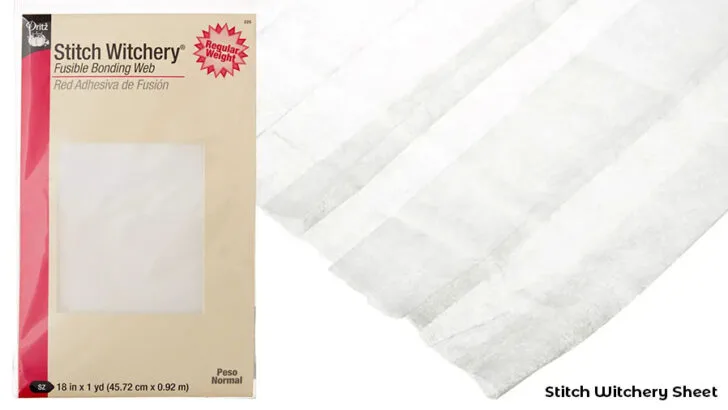If you’re a sewist, chances are you’ve come across the term “stitch witchery bonding web” at some point. But what is it? In short, stitch witchery is a fusible adhesive that can be used for hemming garments, curtains, etc., or attaching trims and appliques.
There are a lot of different ways to hem fabric, but sometimes you just want a quick and easy no-sew solution that will give you professional-looking results. That’s where stitch witchery comes in. In this tutorial, I’ll give you an overview of what stitch witchery is and how to use it.
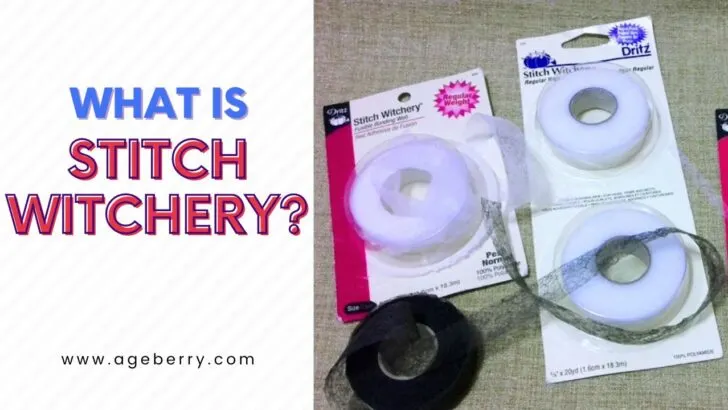
What is Stitch Witchery?
Stitch witchery is a double-sided fusible adhesive that is used to join two pieces of fabric together. Most often it comes in the form of a narrow strip of webbing. But you can also buy sheets of bonding web. Stitch witchery looks like a web, and sometimes it’s called WONDER WEB or BONDING WEB. It melts from the heat of an iron, bonding the fabric together.
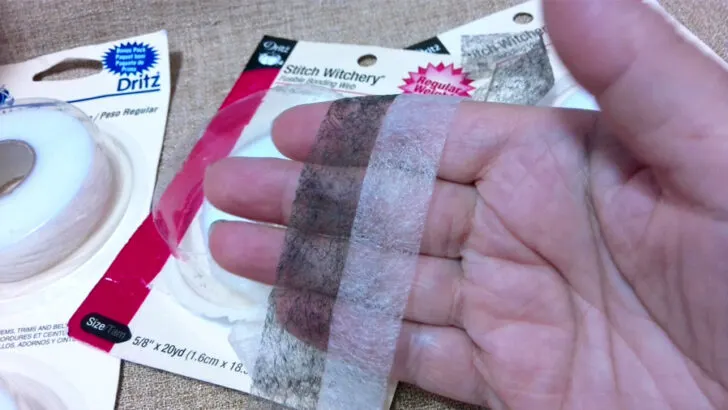
It’s made of heat-activated synthetic material (100% polyamide) that bonds fabric when exposed to heat. When the two pieces of fabric are placed together with the bonding web in between, they can be fused together using an iron.
It’s invisible once applied, so you’ll never have to worry about it showing through. It’s available in different widths, lengths, weights, and colors so you can choose the type that best suits your needs.
What’s the difference between stitch witchery and hem tape? They’re basically the same thing. Stitch witchery is a brand of hem tapes. There are other brands of hem tape available, but stitch witchery is one of the most popular. Simply put, stitch witchery is a type of hem tape. You can use it for hemming, as well as other types of projects. Stitch witchery is a brand name while hem tape is a generic term.
You might be wondering what the difference is between stitch witchery and fusible interfacing. Both of these products are types of fusible adhesive. However, there are some key differences between the two products.
Stitch witchery is a double-sided fusible adhesive that is used to bond two pieces of fabric together. On the other hand, fusible interfacing is a one-sided fusible material that is used to stabilize fabric or add structure to a garment. When choosing which material to use, it is important to consider the specific project that you are working on.
Dritz Stitch Witchery
Dritz is the most popular brand of stitch witchery, and for good reason. Their bonding web is available in different weights and widths to suit a variety of fabrics, from lightweight silk to heavyweight denim.
One single type of stitch witchery is not suitable for all kinds of fabrics.
Dritz stitch witchery is available in three different weights – Regular Weight, Super Weight, and Ultra Light Weight. Each weight has its own properties and uses. When choosing a weight, be sure to base your selection on the weight of the fabric you’re working with.
Note: Some of the links on this page are affiliate links. This means I will receive a commission if you order a product through one of my links. I only recommend products I believe in and use myself.
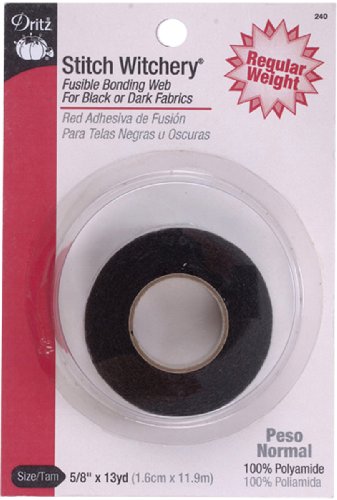
Dritz Stitch Witchery Fusible, 5/8" X 13-Yards, Regular Weight, 1 Roll, Black Bonding Web, 5/8-Inch
A regular weight bonding web is the most useful type and suitable for a wide range of fabrics - all medium weight fabrics like quilting cotton, linen, medium weight wool, some polyester, etc., and also for some lightweight fabrics (like silk satin, apparel cotton, etc.) and some heavier weight fabrics too ( like some types of denim).

Dritz Stitch Witchery, Ultra Light Weight fusible bonding Web, 5/8-Inch X 20-Yards, White
Use an Ultra Light Weight tape with delicate fabrics like silk and rayon. This will help to prevent damage to the fabric while still providing a strong bond.

Dritz - 223 Stitch Witchery Super Weight fusible, 5/8-Inch X 13-Yards, White
For heavier fabrics like upholstery, denim, suede, wool, and corduroy, a heavyweight bonding web is necessary to ensure a lasting connection.
Dritz Super Weight Stitch Witchery
The difference between the Regular and Super Weight is the amount of bonding power they provide.
The Super Weight Stitch Witchery is denser than the Regular and provides more bonding power to the fabric. This makes it ideal for use with heavier fabrics such as upholstery, denim, coat wool, or for projects where a very strong bond is required. The Regular Stitch Witchery is sufficient for most purposes and works well with medium-weight fabrics.
It’s important to use the correct stitch witchery weight with your fabric because using a Super Weight tape with lightweight fabric could result in the glue seeping through the fabric and creating a messy, visible stain on the fabric.
Dritz Stitch Witchery Widths
When you purchase Dritz Stitch Witchery, you will also have the ability to choose between a variety of widths. For your width, choose a size that’s smaller than your hem size so the tape stays out of sight.
You can buy ¼ wide, ⅝ inch, ¾ inch, 1 inch, and 2 inch wide tapes:

Dritz - 227 1/4x20 Stitch Witchery
Dritz - 227 1/4x20 Stitch Witchery 1/4inx 20yd, 1/4-Inch X 20-Yards, White

Dritz 222 Regular Weight 5/8-Inch X 20-Yards
Dritz 222 STITCH WITCHERY FUSIBLE BONDING WEB WHITE REG WGHT 20YD, 5/8-Inch X 20-Yards

Dritz Stitch Witchery Regular Weight, 3/4 Inch x 100 Yards
Dritz Stitch Witchery Fusible Bonding Web, Regular Weight, 3/4 Inch x 100 Yards, White Sewing Adhesive, 3/4-Inch X 100-Yards

Dritz Stitch Witchery Fusible 1-inch X 13-Yards, Regular Weight
Dritz Stitch Witchery Fusible X 13-Yards, Regular Weight, 1 Roll, Black Bonding Web, 1-Inch

Dritz Stitch Witchery Fusible, Super Weight 2-Inch X 10-Yards
Dritz Stitch Witchery Fusible, Super Weight Bonding Web, 2-Inch X 10-Yards, White
There are also different colors of stitch witchery tapes so it makes sense to choose a color that’s matching your fabric. It’s especially important for lightweight fabrics like chiffon. Use white for light-colored fabrics and black for dark-colored fabrics.
Stitch Witchery Sheets
If you’re looking for an easy way to attach patches or appliques without sewing, then stitch witchery sheets are a great option. Yard-sized sheets are perfect for larger projects. To use it, simply cut the fusible adhesive sheet into the shape you need, matching it with the patch you are making or the applique shape. Place it between the appliques and the fabric, and iron. The bond will be strong and permanent, so this is a great option for appliqués, patches, and other fabric crafts.
Stitch Witchery vs. HeatnBond
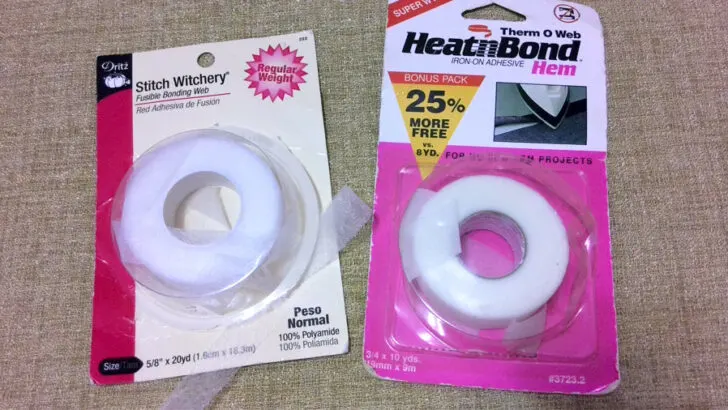
HeatnBond is similar to stitch witchery in that it can be used to bond two pieces of fabric together. However, there are some differences between the two products. For one, HeatnBond doesn’t look like webbing – the tape looks different.
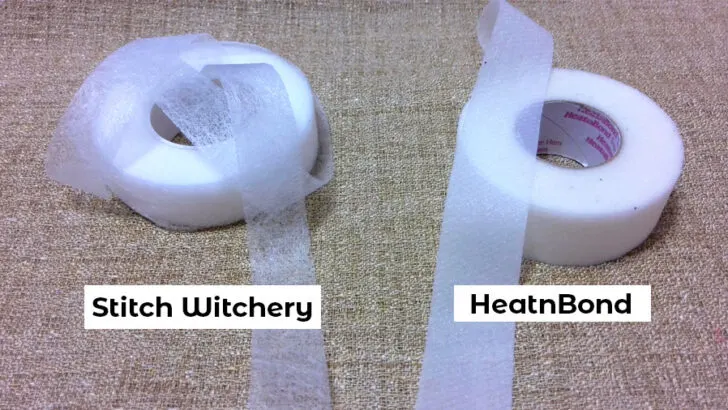
Additionally, when using HeatnBond for hemming, it can appear stiffer or bulkier on the hem than stitch witchery. It might be good for heavier-weight fabrics but for regular apparel fabrics, it can be a problem.
I read reviews on Amazon and see that not all materials work with HeatnBond – you may find that the fabrics don’t stick together when you use this product. However, I have never had this problem, and HeatnBond tapes I have bond fabrics perfectly. What I don’t like is that hem becomes stiffer with HeatnBond than with stitch witchery.
Stitch Witchery vs Fabric Glue
Both stitch witchery and fabric glue have their pros and cons, so ultimately the decision of which one to use comes down to personal preference.
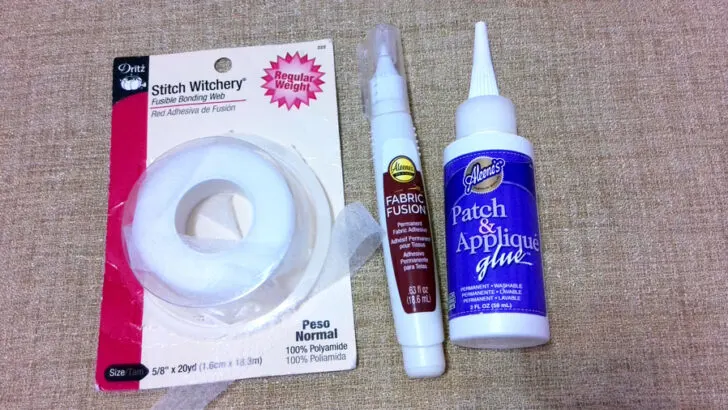
I like to sew, so I have both of these notions in my sewing kit. I notice I use fabric glue more often, however. I find that it’s especially helpful for attaching small items to fabric – items that can’t be applied with fusible tape.
I also like to use fabric glue when working with leather and vinyl. I can’t use stitch witchery with those fabrics, so fabric glue is my go-to option.
Another potential issue is that stitch witchery requires an iron, so if you are sewing on the go, you may not have access to one.
That said, there are some things that stitch witchery is better for. The big advantage of stitch witchery is that it’s very easy to use; even a beginner sewist can get good results with it. It’s great for applique because it doesn’t add any bulk. It’s also perfect for hemming.
And fabric glue can be messy. If you are not careful, you may end up with glue on your fingers or clothes.
Another potential issue is that some fabric glues may not hold up as well as you would like, especially if the bonded fabric will be subject to a lot of wear and tear. Also, if you don’t apply it evenly, you’ll end up with wrinkles or other imperfections in your fabric.
No matter which method you choose, be sure to test it out on a scrap piece of fabric first to get a feel for how it works.
Why Use Stitch Witchery?
If I had my choice, I’d rather use a sewing machine and sew two pieces of fabric together.
But Stitch Witchery is a useful notion when you don’t have time to sew or need to make an emergency quick repair and look for a quick and easy way to hem a dress or some other item. It provides a strong and durable bond between two pieces of fabric. It’s also easy to use, which makes it great for beginners who are just learning the ropes. Additionally, the bonding web can be used on a variety of different fabrics, including delicate fabrics like silk.
How to Use Stitch Witchery Bonding Web
Using stitch witchery is fairly simple. In general, you cut the strip of webbing to the desired length, place it between the two pieces of fabric that you want to bond together, and use an iron to press down on the fabric for 30-60 seconds. For best results, use a pressing cloth when ironing, as this will help to prevent any damage to the fabric. Allow the bonded fabric to cool for 1-2 minutes before handling it.
Detailed stitch witchery instructions (step-by-step) for hemming
#1. Prepare your fabric
Before you can start fusing fabric, you need to prepare the fabric itself.
The first step is to make sure that it is clean. If the fabric is new, this shouldn’t be a problem.
However, if you are using recycled fabric or material from an old garment, you will need to wash it before proceeding. It’s also better to avoid using fabric softener, as this can reduce the bonding ability of the adhesive.
Once the fabric is clean, you need to iron it to get rid of any wrinkles. Make sure to use a correct heat setting, as many fabrics are not safe for high heat ironing so check the care label before proceeding. If everything is ready, you can now start using stitch witchery.
If you want to use stitch witchery for a new fabric you should pre-wash the fabric and trims and therefore pre-shrink them.
#2. Prepare the hem and cut stitch witchery
Once you determined the width of the hem, fold the fabric to the desired width and press the hem with a hot iron.
Measure your hem length and cut stitch witchery tape to the same length (or slightly more, ½”) as the hem or tear you’re using it for.
#3. Insert the bonding web into the hem area
The stitch witchery tape goes in between the layers of fabric, so make sure that it doesn’t poke out from the top of the hem and is completely covered with fabric. You will need to avoid having the tape come in direct contact with your iron, as this will cause the tape to melt and make your iron dirty.
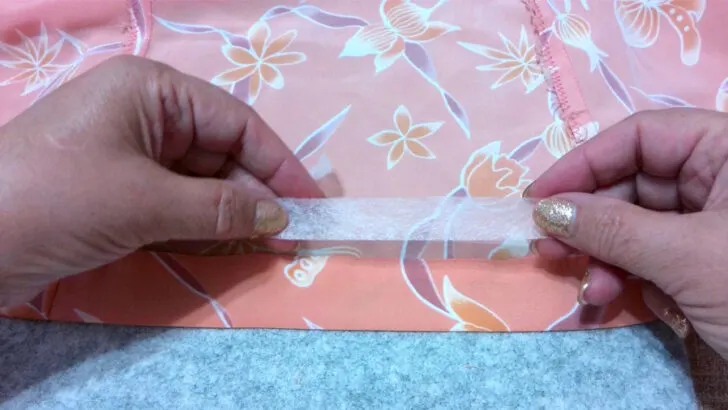
#4. Press the hem with a hot iron
Pressing the hem is the next step in using stitch witchery to finish your garment. Be sure to follow the instructions on the package, particularly with regard to temperature.
Usually, it’s required to press firmly for 10-12 seconds. It’s advisable to increase fusing time on heavier fabrics.
Don’t glide the iron back and forth, just press.
✅ Related tutorial: Basic sewing tools: iron buying guide
You may need to turn fabric pieces over and repeat the process on the other side of the fabric to achieve a smooth, secure bond.
Experiment a bit on a scrap piece of the same or similar fabric to find the right setting on your iron. You’ll likely need your iron on a medium to medium-high setting so it’s hot enough.
If you’re hemming a delicate fabric, use a pressing cloth between the fabric and the iron to prevent any burning.
It’s also important if you’re working with a large area, to break it down into smaller sections. That way, you can keep everything nice and straight. Just take your time and go slowly, and you’ll end up with a great-looking hem that will hold up wash after wash.
#5. Check the seal
Allow the fabric to cool completely before checking the seal – the stitch witchery tape will fuse as it cools, so if you check while the fabric is still hot, it may not seem like the tape is properly fused even if it is.
Once the fabric has cooled, carefully inspect the seal to ensure that there are no gaps or openings. If everything looks good, then you can be confident that your hem will stay in place. This final step is important because it allows the adhesive in the hem tape to set and achieve maximum strength.
Stitch Witchery Temperature
Stitch witchery has a wide range of fabrics it can be used on. Polyester, cotton, linen, and denim are just a few of the many stitch witchery friendly fabrics out there. But one question always seems to arise: what is the stitch witchery temperature?
The answer is not as cut-and-dry as you might think. While there are general guidelines you can follow, ultimately it will come down to trial and error.
That being said, a good place to start is with a medium heat setting or wool setting.
If your iron isn’t hot enough, the adhesive tape won’t melt properly and your project may not fuse together correctly. On the other hand, if your iron is too hot, you run the risk of damaging the fabric. As with anything, it’s best to err on the side of caution and start with a lower heat setting, then increase the temperature if needed.
Test the temperature of your iron on a scrap piece of fabric before using it on your project. That way, you can avoid any potential disasters!
Stitch Witchery Removal
Stitch Witchery is a product that is meant to bond two fabrics together permanently.
However, if you make a mistake while using it, the bond can be broken by steam pressing the fused area for 10 seconds. Once you have done this, you can peel the layers apart while the fabric is still hot. This should allow you to fix any mistakes that you have made and continue with your project.
Stitch Witchery loses its web-like appearance when fused properly.
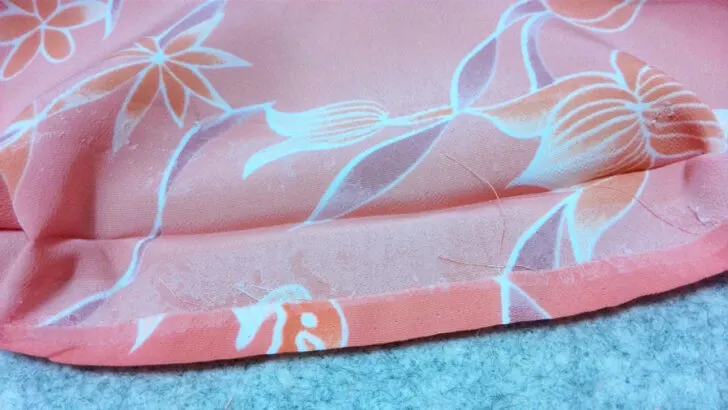
If you’re looking to remove stitch witchery residue from fabric, you’ll likely find it’s not an easy task. This is because stitch witchery is designed to be a permanent adhesive, so it can be quite difficult to remove once it’s been applied. However, there are a few things you can do to try and get rid of as much of the residue as possible.
One way to try to remove excess Stitch Witchery is to cover the area with a damp press cloth and press with a steam iron for 10-15 seconds. The idea is that the excess Stitch Witchery will be absorbed into the press cloth. However, I have never been able to remove all of the residues this way.
If you’re left with stubborn bits of Stitch Witchery, and you really want to remove it from the fabric, you may try another trick. Just press a hot iron over the adhesive, and it should attach to the iron. This will leave your fabric residue-free. Keep in mind that this process will damage your iron, so it’s only worth doing if you’re desperate to remove the adhesive. But I didn’t try this method.
Frequently Asked Questions On Stitch Witchery
Yes, stitch witchery is generally permanent. It works by bonding the fibers of your fabric together, so it’s essentially like sewing the fabric together. It’s meant to replace sewing, stay in place securely, and withstand a number of washings. This can be a great way to mend a tear or fix a hem, and it’ll last.
If you’re wondering how long stitch witchery lasts, the answer is that it depends. The adhesive tape is designed to be permanent, but it can eventually come undone with enough wear and tear.
However, if you sew over the tape, the stitches will hold much longer – even through multiple washings. Ultimately, though, the hem will come undone if you didn’t sew it. This doesn’t mean that Stitch Witchery is not a good option for hemming clothes. It’s still a very effective way to hem clothes, and it will last quite a long time.
There are a few possible reasons why Stitch Witchery may not be working on your fabric. It could be that your fabric is textured and not smooth enough for the adhesive to stick. Or the fabric is not clean. This can make it difficult for the adhesive to bond properly.
Another possibility is that your iron isn’t hot enough. The adhesive needs heat to activate, so if your iron isn’t set to the proper temperature, it won’t work as well. Also, maybe you didn’t hold the iron long enough.
Or you used the type of stitch witchery not suitable for your fabric (for example, too heavy fabric but a regular weight tape).
Yes, you can use stitch witchery on polyester and polyester blends. When using stitch witchery on polyester, it is important to use a low heat setting on your iron and to place a pressing cloth over the top of the fabric. This will help to prevent damage to the polyester fabric. You should also test the stitch witchery on a scrap piece of fabric before using it on your project, just to be sure that it will work well with the polyester fabric you are using.
Yes, it’s dry cleanable. If you’ve used stitch witchery to hem your pants, you might be wondering if it’s safe to take them to a professional dry cleaner. The good news is that clothes with stitch witchery are dry cleanable, and the hem will not be undone. However, you should keep in mind that the bond may not be as strong as it would be if the hem was sewn by hand or machine.
If you’re working with Stitch Witchery and you accidentally get some of it on the soleplate of your iron, don’t panic. It’s not permanently bonded to the surface and can be removed using special products or items easily found in any household like salt, vinegar, etc.
But the best way to remove Stitch Witchery from an iron is to use Faultless iron cleaner. It’s a special product for cleaning irons. It works magic! There is no need to hunt for vinegar or salt only to find they didn’t work. Simply follow the instructions on the Faultless tube. In just a short time, your iron will be clean and free of any residual stitch witchery adhesive.
Yes, it is perfectly possible to sew through stitch witchery with your sewing machine. However, there are a few things you need to keep in mind in order to prevent any adhesive from gumming up your needle. Make sure to use a special non-stick needle. If you do happen to get adhesive on your needle, simply stop the machine and CLEAN IT OFF before continuing.
Yes, you can wash clothes hemmed with stitch witchery. However, the adhesive in the stitch witchery will eventually weaken and start to come undone if it’s washed too many times. So it’s best to sew the hem to keep it in place.
Did you find this tutorial helpful? If so, save this pin (see below) on your sewing board so you can come to this tutorial later when you need this information on stitch witchery, and follow me on Pinterest for more tips, tutorials, and inspiration!
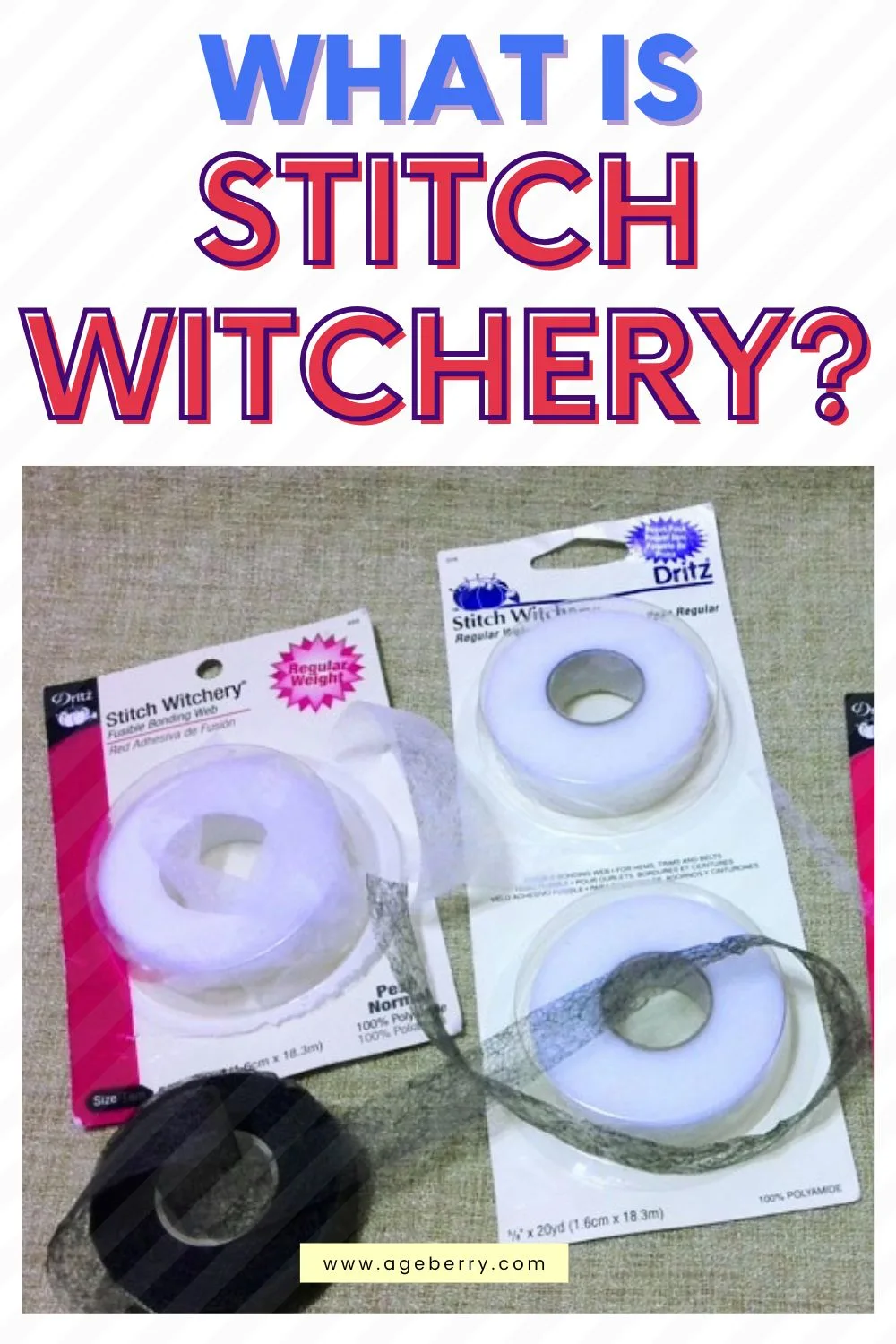
latest posts
- Ever Tried This on Your Serger? This Differential Feed Feature Will Amaze You
- Ditch My Sewing Machine? Not in This Lifetime!
- Adorable DIY Needle Book | Easy Tutorial for Beginners
- Master the Seam Ripper: Your Ultimate Guide to Precision Stitch Removal
- Think You Know Zippers? This Installation Guide Might Surprise You
- Why Does Your Seam Ripper Have a Red Ball? Discover Its Purpose!
- Topstitching Troubles? This Simple Trick Will Turn It Around Instantly!
- How to Sew Shirring: A Step-by-Step Guide to Elastic Thread Gathering
- Are Self-Threading Needles Really Useful?

